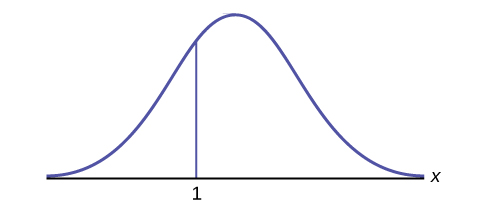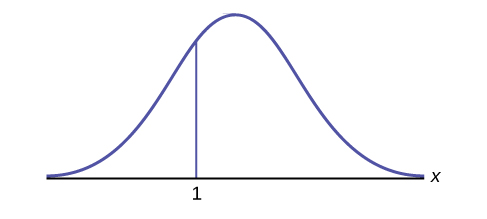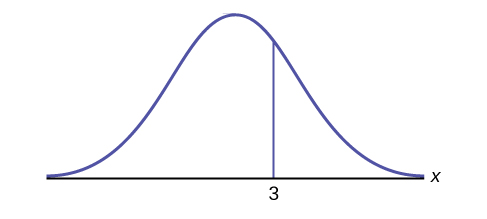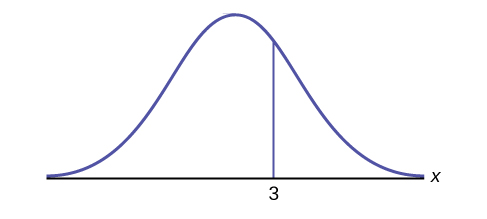5.6 Exercises
1. A bottle of water contains 12.05 fluid ounces with a standard deviation of 0.01 ounces. Define the random variable [latex]X[/latex] in words.
2. A normal distribution has a mean of 61 and a standard deviation of 15. What is the median?
3. A company manufactures rubber balls. The mean diameter of a ball is 12 cm with a standard deviation of 0.2 cm. Define the random variable [latex]X[/latex] in words.
4. What does a [latex]z[/latex]-score measure?
5. What does standardizing a normal distribution do to the mean?
6. What is the [latex]z[/latex]-score of [latex]x = 12[/latex] if it is two standard deviations to the right of the mean?
7. What is the [latex]z[/latex]-score of [latex]x = 9[/latex] if it is 1.5 standard deviations to the left of the mean?
8. What is the [latex]z[/latex]-score of [latex]x = –2[/latex] if it is 2.78 standard deviations to the right of the mean?
9. What is the [latex]z[/latex]-score of [latex]x = 7[/latex] if it is 0.133 standard deviations to the left of the mean?
10. Suppose [latex]X[/latex] is a normal random variable with a mean of 2 and standard deviation of 6. What value of [latex]x[/latex] has a [latex]z[/latex]-score of three?
11. Suppose [latex]X[/latex] is a normal random variable with a mean of 8 and standard deviation of 1. What value of [latex]x[/latex] has a [latex]z[/latex]-score of [latex]-2.25[/latex]?
12. Suppose [latex]X[/latex] is a normal random variable with a mean of 9 and standard deviation of 5. What value of [latex]x[/latex] has a [latex]z[/latex]-score of [latex]-0.5[/latex]?
13. Suppose [latex]X[/latex] is a normal random variable with a mean of 2 and standard deviation of 3. What value of [latex]x[/latex] has a [latex]z[/latex]-score of [latex]-0.67[/latex]?
15. Suppose [latex]X[/latex] is a normal random variable with a mean of 4 and standard deviation of 2. What value of [latex]x[/latex] is 2 standard deviations to the right of the mean?
16. Suppose [latex]X[/latex] is a normal random variable with a mean of 8 and standard deviation of 9. What value of [latex]x[/latex] is 0.67 standard deviations to the left of the mean?
17. Suppose [latex]X[/latex] is a normal random variable with a mean of [latex]-1[/latex] and standard deviation of 2. What is the [latex]z[/latex]-score of [latex]x=2[/latex]?
18. Suppose [latex]X[/latex] is a normal random variable with a mean of 12 and standard deviation of 6. What is the [latex]z[/latex]-score of [latex]x=2[/latex]?
19. Suppose [latex]X[/latex] is a normal random variable with a mean of 9 and standard deviation of 3. What is the [latex]z[/latex]-score of [latex]x=9[/latex]?
20. Suppose a normal distribution has a mean of six and a standard deviation of 1.5. What is the [latex]z[/latex]-score of [latex]x = 5.5[/latex]?
21. In a normal distribution, [latex]x = 5[/latex] and [latex]z = –1.25[/latex]. This tells you that [latex]x = 5[/latex] is ____ standard deviations to the ____ (right or left) of the mean.
22. In a normal distribution, [latex]x = 3[/latex] and [latex]z = 0.67[/latex]. This tells you that [latex]x = 3[/latex] is ____ standard deviations to the ____ (right or left) of the mean.
23. In a normal distribution, [latex]x = –2[/latex] and [latex]z = 6[/latex]. This tells you that [latex]x = –2[/latex] is ____ standard deviations to the ____ (right or left) of the mean.
24. In a normal distribution, [latex]x = –5[/latex] and [latex]z=-3.14[/latex]. This tells you that [latex]x = –5[/latex] is ____ standard deviations to the ____ (right or left) of the mean.
25. In a normal distribution, [latex]x = 6[/latex] and [latex]z = –1.7[/latex]. This tells you that [latex]x = 6[/latex] is ____ standard deviations to the ____ (right or left) of the mean.
26. About what percent of [latex]x[/latex] values from a normal distribution lie within one standard deviation (left and right) of the mean of that distribution?
27. About what percent of the [latex]x[/latex] values from a normal distribution lie within two standard deviations (left and right) of the mean of that distribution?
28. About what percent of [latex]x[/latex] values lie between the second and third standard deviations (both sides)?
29. Suppose [latex]X[/latex] is a normal random variable with mean 15 and standard deviation 3. Between what [latex]x[/latex] values does [latex]68.27\%[/latex] of the data lie? The range of [latex]x[/latex] values is centered at the mean of the distribution (i.e., 15).
30. Suppose [latex]X[/latex] is a normal random variable with mean [latex]-3[/latex] and standard deviation [latex]1[/latex]. Between what [latex]x[/latex] values does [latex]95.45\%[/latex] of the data lie? The range of [latex]x[/latex] values is centered at the mean of the distribution(i.e., –3).
31. Suppose [latex]X[/latex] is a normal random variable with mean [latex]-3[/latex] and standard deviation [latex]1[/latex]. Between what [latex]x[/latex] values does 34.14% of the data lie?
32. About what percent of [latex]x[/latex] values lie between the mean and three standard deviations?
33. About what percent of [latex]x[/latex] values lie between the mean and one standard deviation?
34. About what percent of [latex]x[/latex] values lie between the first and second standard deviations from the mean (both sides)?
36. The patient recovery time from a particular surgical procedure is normally distributed with a mean of 5.3 days and a standard deviation of 2.1 days.
- What is the median recovery time?
- What is the [latex]z[/latex]-score for a patient who takes ten days to recover?
37. The length of time to find it takes to find a parking space at 9 A.M. follows a normal distribution with a mean of five minutes and a standard deviation of two minutes. If the mean is significantly greater than the standard deviation, which of the following statements is true?
- The data cannot follow the uniform distribution.
- The data cannot follow the exponential distribution..
- The data cannot follow the normal distribution.
38. The heights of the 430 National Basketball Association players were listed on team rosters at the start of the 2005–2006 season. The heights of basketball players have an approximate normal distribution with mean [latex]\mu = 79[/latex] inches and a standard deviation [latex]\sigma = 3.89[/latex] inches. For each of the following heights, calculate the [latex]z[/latex]-score and interpret it using complete sentences.
- 77 inches
- 85 inches
- If an NBA player reported his height had a [latex]z[/latex]-score of 3.5, would you believe him? Explain your answer.
39. The systolic blood pressure (given in millimeters) of males has an approximately normal distribution with mean [latex]\mu = 125[/latex] and standard deviation [latex]\sigma = 14[/latex]. Systolic blood pressure for males follows a normal distribution.
- Calculate the [latex]z[/latex]-scores for the male systolic blood pressures 100 and 150 millimeters.
- If a male friend of yours said he thought his systolic blood pressure was 2.5 standard deviations below the mean, but that he believed his blood pressure was between 100 and 150 millimeters, what would you say to him?
40. Kyle’s doctor told him that the [latex]z[/latex]-score for his systolic blood pressure is 1.75. Which of the following is the best interpretation of this standardized score? The systolic blood pressure (given in millimeters) of males has an approximately normal distribution with mean [latex]\mu = 125[/latex] and standard deviation [latex]\sigma = 14[/latex].
- Which answer(s) is/are correct?
- Kyle’s systolic blood pressure is 175.
- Kyle’s systolic blood pressure is 1.75 times the average blood pressure of men his age.
- Kyle’s systolic blood pressure is 1.75 above the average systolic blood pressure of men his age.
- Kyles’s systolic blood pressure is 1.75 standard deviations above the average systolic blood pressure for men.
- Calculate Kyle’s blood pressure.
41. Height and weight are two measurements used to track a child’s development. The World Health Organization measures child development by comparing the weights of children who are the same height and the same gender. In 2009, weights for all 80 cm girls in the reference population had a mean [latex]\mu = 10.2[/latex] kg and standard deviation [latex]\sigma = 0.8[/latex] kg. Weights are normally distributed. Calculate the [latex]z[/latex]-scores that correspond to the following weights and interpret them.
- 11 kg
- 7.9 kg
- 12.2 kg
42. In 2005, 1,475,623 students heading to college took the SAT. The distribution of scores in the math section of the SAT follows a normal distribution with mean [latex]\mu= 520[/latex] and standard deviation [latex]\sigma = 115[/latex].
- Calculate the [latex]z[/latex]-score for an SAT score of 720. Interpret it using a complete sentence.
- What math SAT score is 1.5 standard deviations above the mean? What can you say about this SAT score?
- For 2012, the SAT math test had a mean of 514 and standard deviation 117. The ACT math test is an alternate to the SAT and is approximately normally distributed with mean 21 and standard deviation 5.3. If one person took the SAT math test and scored 700 and a second person took the ACT math test and scored 30, who did better with respect to the test they took?
43. How would you represent the area to the left of one in a probability statement?

44. What is the area to the right of one?

45. Is [latex]P(x \lt 1)[/latex]equal to [latex]P(x \geq 1)[/latex]? Why?
46. How would you represent the area to the left of three in a probability statement?

47. What is the area to the right of three?

49. If the area to the right of [latex]x[/latex] in a normal distribution is 0.543, what is the area to the left of [latex]x[/latex]?
- Find the probability that [latex]x \gt 56[/latex].
- Find the probability that [latex]x \lt 30[/latex].
- Find the probability that [latex]40 \lt x \lt 50[/latex]
- 80% of the [latex]x[/latex]-values are less than what value?
- 40% of the [latex]x[/latex]-values are greater than what value?
51. The life of Sunshine CD players is normally distributed with a mean of 4.1 years and a standard deviation of 1.3 years.
- A CD player is guaranteed for three years. Find the probability that a CD player will break down during the guarantee period.
- Find the probability that a CD player will last between 2.8 and 6 years.
- 70% of the CD players last how long?
52. The patient recovery time from a particular surgical procedure is normally distributed with a mean of 5.3 days and a standard deviation of 2.1 days.
- What is the probability of spending more than two days in recovery?
- 10% of the recovery times are larger than what value?
53. The length of time it takes to find a parking space at 9 A.M. follows a normal distribution with a mean of five minutes and a standard deviation of two minutes.
- Based upon the given information and numerically justified, would you be surprised if it took less than one minute to find a parking space?
- Find the probability that it takes at least eight minutes to find a parking space.
- Seventy percent of the time, it takes more than how many minutes to find a parking space?
54. According to a study done by De Anza students, the height for Asian adult males is normally distributed with an average of 66 inches and a standard deviation of 2.5 inches. Suppose one Asian adult male is randomly chosen. Let [latex]X[/latex] be the height of the individual.
- Find the probability that the person is between 65 and 69 inches. Include a sketch of the graph, and write a probability statement.
- Would you expect to meet many Asian adult males over 72 inches? Explain why or why not, and justify your answer numerically.
- The middle 40% of heights fall between what two values? Sketch the graph, and write the probability statement.
55. IQ is normally distributed with a mean of 100 and a standard deviation of 15. Suppose one individual is randomly chosen. Let [latex]X[/latex] be IQ of an individual.
- Find the probability that the person has an IQ greater than 120. Include a sketch of the graph, and write a probability statement.
- MENSA is an organization whose members have the top 2% of all IQs. Find the minimum IQ needed to qualify for the MENSA organization. Sketch the graph, and write the probability statement.
- The middle 50% of IQs fall between what two values? Sketch the graph and write the probability statement.
56. The percent of fat calories that a person in America consumes each day is normally distributed with a mean of about 36 and a standard deviation of 10. Suppose that one individual is randomly chosen. Let [latex]X[/latex] be percent of fat calories.
- Find the probability that the percent of fat calories a person consumes is more than 40. Graph the situation. Shade in the area to be determined.
- Find the maximum number for the lower quarter of percent of fat calories. Sketch the graph and write the probability statement.
57. Suppose that the distance of fly balls hit to the outfield (in baseball) is normally distributed with a mean of 250 feet and a standard deviation of 50 feet.
- If one fly ball is randomly chosen from this distribution, what is the probability that this ball traveled fewer than 220 feet? Sketch the graph. Scale the horizontal axis X. Shade the region corresponding to the probability. Find the probability.
- 80% of fly balls travel for less than what value?
58. In China, four-year-olds average three hours a day unsupervised. Most of the unsupervised children live in rural areas, considered safe. Suppose that the standard deviation is 1.5 hours and the amount of time spent alone is normally distributed. We randomly select one Chinese four-year-old living in a rural area. We are interested in the amount of time the child spends alone per day.
- Find the probability that the child spends less than one hour per day unsupervised. Sketch the graph, and write the probability statement.
- What percent of the children spend over ten hours per day unsupervised?
- Seventy percent of the children spend at least how long per day unsupervised?
59. In the 1992 presidential election, Alaska’s 40 election districts averaged 1,956.8 votes per district for President Clinton. The standard deviation was 572.3. (There are only 40 election districts in Alaska.) The distribution of the votes per district for President Clinton was bell-shaped. Let [latex]X[/latex] be number of votes for President Clinton for an election district.
- Is 1,956.8 a population mean or a sample mean? How do you know?
- Find the probability that a randomly selected district had fewer than 1,600 votes for President Clinton. Sketch the graph and write the probability statement.
- Find the probability that a randomly selected district had between 1,800 and 2,000 votes for President Clinton.
- 25% of the number of votes for President Clinton is higher than what value?
60. Suppose that the duration of a particular type of criminal trial is known to be normally distributed with a mean of 21 days and a standard deviation of seven days.
- If one of the trials is randomly chosen, find the probability that it lasted at least 24 days. Sketch the graph and write the probability statement.
- Sixty percent of all trials of this type are completed within how many days?
61. Terri Vogel, an amateur motorcycle racer, averages 129.71 seconds per 2.5 mile lap (in a seven-lap race) with a standard deviation of 2.28 seconds. The distribution of her race times is normally distributed. We are interested in one of her randomly selected laps.
- Find the percent of her laps that are completed in less than 130 seconds.
- The fastest 3% of her laps are under what value.
- The middle 80% of her laps are between what values?
- Ricardo’s actual GPA is lower than Anita’s actual GPA.
- Ricardo is not passing because his z-score is zero.
- Anita is in the 70th percentile of students at her college.
64. A NUMMI assembly line, which has been operating since 1984, has built an average of 6,000 cars and trucks a week. Generally, 10% of the cars were defective coming off the assembly line. Suppose we draw a random sample of [latex]n = 100[/latex] cars. Let [latex]X[/latex] represent the number of defective cars in the sample. What can we say about X in regard to the 68-95-99.7 empirical rule (one standard deviation, two standard deviations and three standard deviations from the mean are being referred to)? Assume a normal distribution for the defective cars in the sample.
65. We flip a coin 100 times ([latex]n = 100[/latex]) and note that it only comes up heads 20% ([latex]p = 0.20[/latex]) of the time. The mean and standard deviation for the number of times the coin lands on heads is [latex]\mu=20[/latex]and [latex]\sigma= 4[/latex] (verify the mean and standard deviation). Solve the following:
- There is about a 68% chance that the number of heads will be somewhere between ___ and ___.
- There is about a ____chance that the number of heads will be somewhere between 12 and 28.
- There is about a ____ chance that the number of heads will be somewhere between eight and 32.
66. A $1 scratch off lotto ticket will be a winner one out of five times. Out of a shipment of [latex]n = 190[/latex] lotto tickets, find the probability for the lotto tickets that there are
- somewhere between 34 and 54 prizes.
- somewhere between 54 and 64 prizes.
- more than 64 prizes.
67. Facebook provides a variety of statistics on its Web site that detail the growth and popularity of the site. On average, 28 percent of 18 to 34 year olds check their Facebook profiles before getting out of bed in the morning. Suppose this percentage follows a normal distribution with a standard deviation of five percent.
- Find the probability that the percent of 18 to 34-year-olds who check Facebook before getting out of bed in the morning is at least 30.
- 95% of the number of 18 to 34-year-olds who check Facebook before getting out of bed is less than what value?
Attribution
“Chapter 6 Practice” in Introductory Statistics by OpenStax is licensed under a Creative Commons Attribution 4.0 International License.

